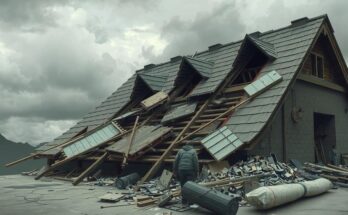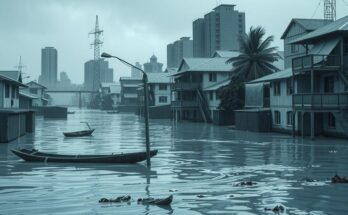The eastern United States faces nearly nonstop winter storms for the upcoming weeks, driven by a stable jet stream. The first storm, starting Wednesday, will produce a hazardous mix of wintry precipitation, particularly ice, impacting travel and power supply. New storms will follow soon, prolonging the winter weather pattern into mid-February.
The eastern United States is bracing for a series of intense winter storms that could persist for several weeks. A stable jet stream, flowing straight from west to east, is projected to direct multiple storms across the northern areas of the contiguous U.S. These storms will likely continue to reoccur until the jet stream shifts, which is not expected until later in February.
The first of these storms is anticipated to form on Wednesday over the central Mississippi Valley, unleashing winter weather across a vast expanse from Missouri to Maine. This initial storm will strengthen overnight, resulting in a complex mix of sleet, freezing rain, snow, and rain from the Midwest to parts of the Northeast through Thursday.
Among the significant threats posed by this storm is hazardous ice accumulation, which could cause power outages and create treacherous driving conditions. An icy mass stretching from Missouri to southern New England is forecasted to develop, with the potential for at least a light glaze of ice coating roads and surfaces.
The most significant risks for ice accumulation exceeding 0.10 inches appear to be from northern Indiana and Ohio extending into central Pennsylvania and the mountainous regions of Maryland, West Virginia, and Virginia. In some locations, particularly central and southern Pennsylvania and western Maryland, ice accumulation could exceed 0.25 inches, significantly increasing the likelihood of downed trees and power lines.
While snowfall will be limited except in the northern Great Lakes, a mixture of precipitation types, including sleet, freezing rain, and rain, is anticipated. Cities like Chicago may initially experience sleet and freezing rain, transitioning predominantly to freezing rain overnight, while Cleveland may see a similar precipitation pattern leading to rain as temperatures rise.
As this storm progresses into the Northeast, particularly Pennsylvania, a messy combination of sleet and freezing rain is expected. Although warmer air will arrive on Thursday to assist with melting, it will be shortly followed by another cold front bringing additional severe weather.
The forecast indicates another storm developing in the Plains late Friday, gaining strength through Saturday. This impending storm is likely to mirror the current event, spreading a similar mix of snow, sleet, freezing rain, and rain across the same affected areas.
Subsequent storms are also projected for the following week, continuing the trend of unstable weather across the eastern half of the United States. Model forecasts suggest another widespread storm could materialize by next Tuesday and Wednesday, with yet another possible around mid-February.
The United States is currently experiencing an active winter weather pattern, particularly affecting the eastern regions. Meteorologically, the jet stream plays a crucial role in storm formation and trajectory. Its stable west-to-east flow is responsible for the series of storms expected to sweep across the northern states. Understanding this background is necessary to grasp the significance of the impending winter conditions and associated dangers.
In summary, the eastern United States is set for a prolonged period of winter storms driven by a stable jet stream. The first storm, commencing Wednesday, will bring various forms of precipitation, primarily ice, leading to significant hazards, including power outages and unsafe travel. Forecasts indicate that subsequent storms will continue this trend into mid-February, making winter weather a persistent concern for the region.
Original Source: www.cnn.com




